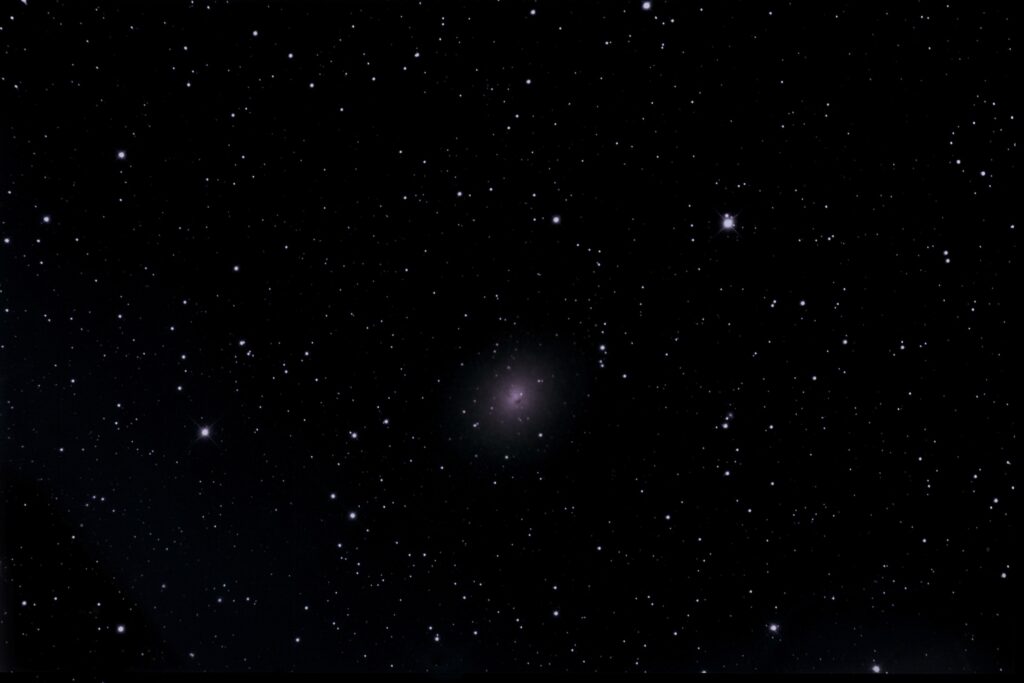Most people know that stars can have orbiting planets, and planets can have orbiting moons (our planet has one). But what is not commonly understood is that galaxies can have orbiting dwarf galaxies. Our Milky Way galaxy has no less than 13, including the Large and Small Magellanic Clouds (naked eye objects in our southern hemisphere), the Sagittarius Dwarf Galaxy, and the Canis Major Dwarf Galaxy.
The closest of the known satellite galaxies is the Canis Major Dwarf, which is a mere 42,000 light years from the center of our galaxy, and is heavily disturbed by the gravitational effect of our much larger galaxy which has resulted in a highly irregular shape. The next closest orbiting galaxy is the Sagittarius Dwarf, at a computed distance of 50,000 light years from the center of our galaxy. By comparison, our Sun is located 25,000 light years from the galactic center.
Other galaxies also have orbiting dwarf galaxies. Our neighbor, the massive Andromeda Galaxy, has several, including the prominent Messier objects 32 and 110, which lie near the galaxy's perimeter. But the Andromeda Galaxy has some more distant, and fainter, children, including NGC 185 (depicted in this 4-hour image).
NGC 185 is a dwarf elliptical galaxy, and is assumed to be a satellite of the Andromeda Galaxy because they both have similar spectral redshifts (corresponding to their radial velocity). In fact, both objects have a negative redshift, which means that they are approaching us rather than receding from us. A negative redshift is sometimes referred to as a blueshift.
NGC 185 is an immense distance from the Andromeda Galaxy. From our perspective, it is a whopping 7 degrees away, in another constellation (Cassiopeia), which corresponds to the same angular distance as 15 full Moons or the width of the bowl of the "big dipper." At this massive distance, its orbital speed must be very low, and its orbital period exceedingly long, in much the same way as Pluto orbits the Sun more slowly, and in a much longer interval, than Mercury (according to Kepler's second and third laws of planetary motion).
Apparently it is currently on "our side" of the Andromeda Galaxy, since its computed distance is 2 million light years compared to 2.5 million light years for its large neighbor.
Two additional points. First, note the faint (magnitude 16) galaxy PGC2318158 to the right of NGC 185. Second, the brightest star in this image is SAO36556, to the upper right of the galaxy. Though it looks bright in this image, at magnitude 8.6 it would not be visible to the unaided eye even under the darkest skies.
Dwarf Galaxy NGC185
Date Taken:August 31, 2009
Location Taken: Conditions of Location:1.9 FWHM
Equipment Used:14.5" Ritchey-Chretien telescope, SBIG STL11000 CCD camera, Astrodon RGB filters, TCC, PIR, remote guide head used with Takahashi Sky90 for autoguiding, T-Point used for polar alignment (required for each imaging session due to my portable setup).
Processing Used:15 x 600 seconds luminance, 8 x 200 seconds RGB, guided (using a remote guide head and Takahashi Sky90 refractor telescope), 1x1 binning, processed in Maxim DL and Photoshop (total exposure 3 hours 50 minutes).
Distance from Location:2.3 million light years
Constellation:Cassiopeia (mythological wife of King Cepheus)
Other Link:
